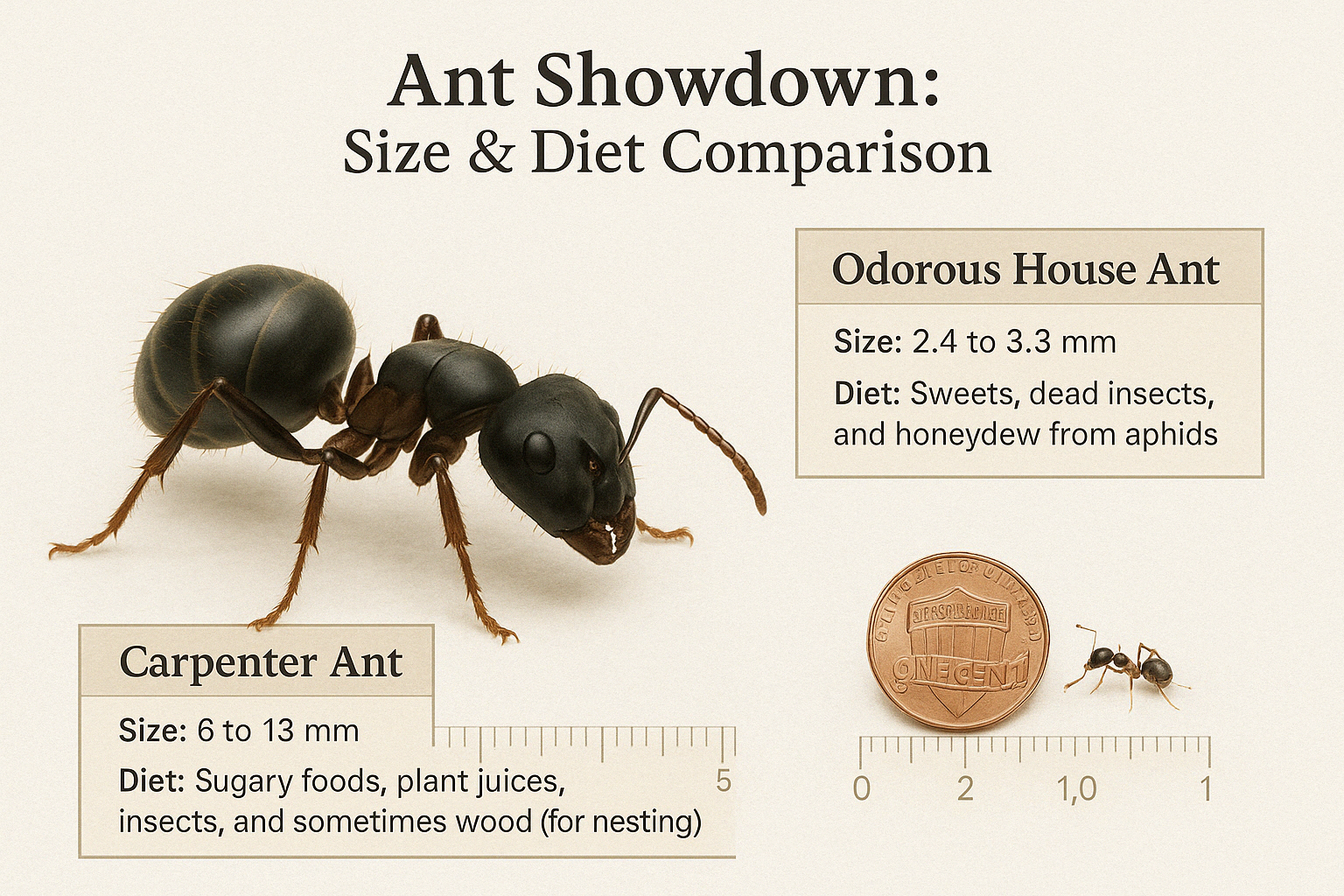You’ve spotted ants marching across your kitchen counter or perhaps noticed some suspicious activity near a window frame. It’s a common annoyance for homeowners, but before you grab the nearest can of bug spray, it’s crucial to know which ant you’re dealing with. Not all ants pose the same threat. Two frequent invaders are Carpenter Ants and Odorous House Ants (OHAs), and confusing them can lead to ineffective treatments, persistent frustration, or even costly property damage.
Misidentification is a common problem. Treating Odorous House Ants like Carpenter Ants might be overkill, while treating destructive Carpenter Ants like simple nuisance ants could allow significant structural damage to progress unnoticed. This post will break down the key differences in appearance, behavior, habitat, and the specific risks each ant poses, helping you correctly identify your unwanted guests.
Size and Appearance: The First Visual Clues
One of the most immediate differences is size and overall look:
Carpenter Ants:
- Size: These are the larger ants you might encounter indoors, typically measuring 1/4 to 1/2 inch long.
- Swarmers: Their winged reproductives (swarmers) are even larger, sometimes reaching nearly an inch long with noticeably long wings.
- Color: Their color can vary significantly. They might be black, reddish, yellowish, or even a combination, such as having a reddish thorax and a black abdomen.
- Distinguishing Features: Look for a smooth, evenly rounded profile on their thorax (the middle body section) and large, pronounced mandibles (jaws) used for chewing through wood.
Odorous House Ants (OHAs):
- Size: These ants are much smaller, typically only 1/16 to 1/8 inch long.
- Color: They are usually a uniform dark brown or black.
- Distinguishing Features: They have smooth, hairless bodies and a single, less distinct waist segment (pedicel) compared to some other ant species. Their most unique identifier isn’t visual – it’s the distinctive pungent odor, often described as rotten coconut or blue cheese, that they release when crushed.

Behavior and Habitat: Where They Live and What They Do
Their lifestyles and nesting habits are fundamentally different:
Carpenter Ants:
- Nesting Preference: They primarily seek out moist, decaying, or hollow wood to establish their nests.
- Habitat: Outdoors, find them in tree trunks, branches, stumps, and woodpiles. Indoors, they target structural wood, often near moisture sources like leaky pipes, poorly sealed windows, or damp crawl spaces.
- Key Behavior: Critically, Carpenter Ants do not eat wood like termites. Instead, they tunnel through it, excavating smooth galleries to create nest sites. This excavation process leaves behind piles of coarse sawdust-like material called “frass.”
- Activity Pattern: They are often nocturnal, so you might see them foraging for food (like sweets or other insects) mostly at night, often following established trails along foundations, fences, or tree limbs.
Odorous House Ants (OHAs):
- Nesting Preference: These ants are highly adaptable opportunists, mainly seeking moisture and shelter.
- Habitat (Indoors): They frequently nest in wall voids near plumbing, under sinks, behind leaky appliances (like dishwashers), in insulation, or even beneath loose tiles.
- Habitat (Outdoors): Common nesting spots include under rocks, logs, patio blocks, landscape mulch, or simply in shallow soil depressions.
- Key Behavior: OHAs are notorious sweet-seekers, often invading kitchens and pantries in search of sugary spills, crumbs, or ripe fruit. They forage widely and lay down chemical trails, often resulting in noticeable lines of ants marching towards a food source. They tend to move quickly and erratically when disturbed.
- Activity Pattern: They are active both day and night.
Damage and Risks: Understanding the Threat Level
The potential impact these ants have on your home varies greatly:
Carpenter Ants:
- Primary Risk: Structural Damage. Their tunneling activities weaken wooden structures over time. Joists, studs, beams, and window frames can all be compromised.
- Significance: Left untreated, Carpenter Ant infestations can lead to significant, costly repairs and compromise the structural integrity of your home. They are classified as a serious wood-destroying pest.
- Bites/Stings: They do not sting. However, larger workers possess strong mandibles and can deliver a noticeable pinch or bite if handled or threatened, though they are not typically aggressive.
Odorous House Ants (OHAs):
- Primary Risk: Nuisance and Food Contamination. Their sheer numbers and persistence in foraging through kitchens and food storage areas are the main issues.
- Significance: While annoying, the bigger concern is their potential to walk across unsanitary areas (like garbage or drains) and then contaminate food or food preparation surfaces. They can potentially carry bacteria like Salmonella or E. coli.
- Structural Damage: None. They do not damage wood or structural components of a building.
- Bites/Stings: They are harmless to humans and pets; they do not bite or sting.
Quick Comparison: Summary Table
Here’s a quick reference guide highlighting the key differences:
| Feature | Carpenter Ants | Odorous House Ants |
|---|---|---|
| Size | ¼ to ½ inches | 1/16 to 1/8 inches |
| Color | Black, red, yellow, or combo of both | Brown to black |
| Appearance | Smooth thorax, large mandibles | Smooth, hairless body, single pedicel |
| Nesting Habits | Inside decayed or hollow wood | Indoors and outdoors in moist areas |
| Behavior | Tunnel through wood, nocturnal | Forage in kitchens, quick, line-traveling |
| Structural Damage | Yes, wood-damaging | No |
| Bites/Stings | Usually none, but mandibles can bite | Harmless, no bites or stings |
Conclusion: Why Identification Matters & Taking Action with STL Pest Control
As we’ve seen, Carpenter Ants and Odorous House Ants present very different challenges. Carpenter Ants are large wood-destroyers requiring serious attention due to potential structural damage, while the small, dark Odorous House Ants are primarily nuisance pests known for contaminating food and emitting a foul odor when crushed.
Correct identification is the absolute first step towards effective control. Knowing the difference helps you understand the specific risks involved. However, while identifying these differences is helpful, tackling an infestation, especially one involving potential wood-destroying Carpenter Ants, truly requires professional expertise.
Why Choose STL Pest Control?
- Certainty Matters: Are you absolutely sure it’s just Odorous House Ants trailing across your floor? Misidentifying Carpenter Ants can lead to unnoticed structural damage accumulating over time, resulting in expensive repairs later. Don’t risk your property’s value – get a professional assessment from experts who know St. Louis pests.
- Expert Identification & Targeted Treatment: The experienced technicians at STL Pest Control can accurately identify whether you’re dealing with Carpenter Ants, Odorous House Ants, pavement ants, or another species entirely. This precise identification ensures the most effective treatment plan is implemented, saving you time, money, and the frustration of failed DIY attempts.
- Protect Your Investment: If Carpenter Ants are suspected or confirmed, immediate professional intervention is crucial. STL Pest Control understands how to locate hidden nests within walls, attics, or crawl spaces and uses proven strategies to eliminate the colony, halt the damage, and protect the integrity of your home.
- Eliminate Persistent Nuisances: Even “harmless” Odorous House Ants can be incredibly persistent and difficult to fully eradicate due to their multiple nesting sites and determined foraging. STL Pest Control utilizes professional-grade products and techniques to target OHA colonies at their source, addressing entry points and resolving food contamination concerns efficiently.
- Peace of Mind: Stop guessing which ant is which and worrying about potential damage or contamination. Let the professionals at STL Pest Control take care of your ant problem quickly, effectively, and safely.
Don’t let ants take over your home! Contact STL Pest Control today for a consultation and take the first decisive step towards an ant-free living space.

